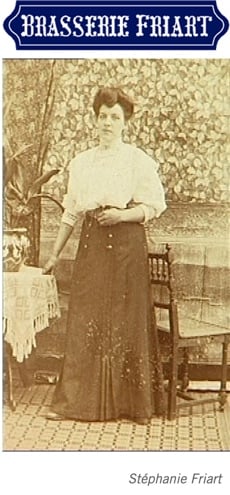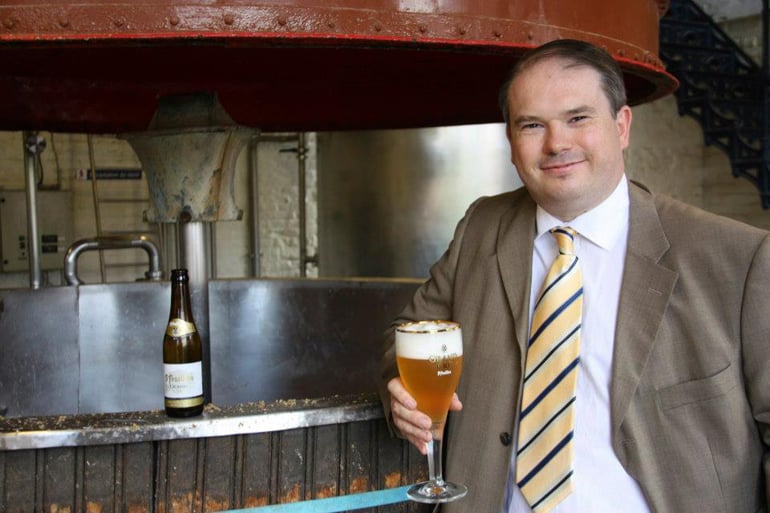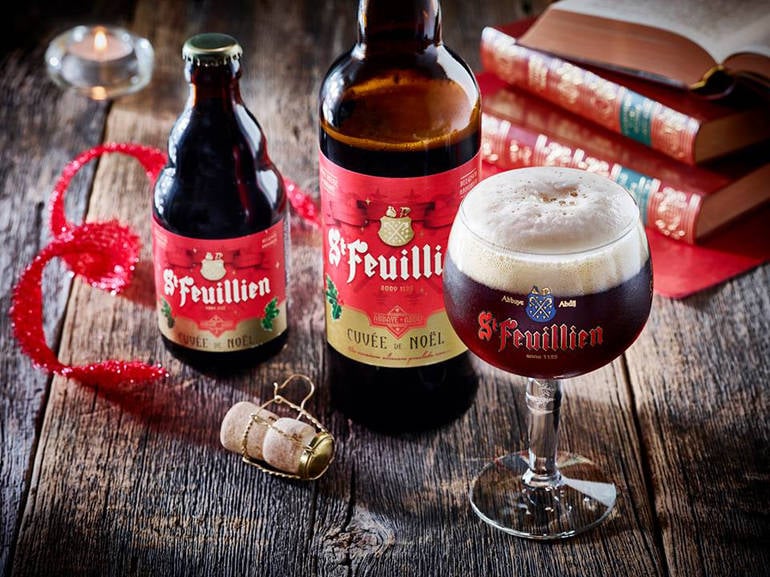Start 14-Day Trial Subscription
*No credit card required

The Story of St. Feuillien Brewery and Its World-Class Beers
In an age of explosive experimentation there are a distinguished few breweries which rely on time-honored, traditional beers to stake their craft beer claim. Unlike the majority of brewers, which have been around a few decades at most, these breweries have been around for generations, largely unchanged, because the beer they make is essentially perfect – with recipes chiseled and honed over thousands of brew cycles by some of the most experienced makers in the land.
Amongst this select group, St. Feuillien (pronounced foo-yen) Brewery of Le Roeulx, Belgium stands out not only because it’s been producing top-quality abbey ales since 1873, but it’s remained in the same family for its entire tenure, save for an 11-year hiatus from 1977 to 1988.
That sort of consistency and longevity is impressive in any business, let alone one based on a living product. Before we look at the beers themselves, some older and some newer, we’ll examine a few aspects that have been key to St. Feuillien’s success.
 A Respect for Tradition
A Respect for Tradition
St. Feuillien Brewery draws local history for its name. In the 7th century, an Irish monk named Foylan traveled to spread his gospel, staying in nearby Fosses-la-Villes, where artifacts of his can still be found today. Foylan met a gruesome end – while travelling near Le Roeulx, he was robbed, tortured and decapitated.
Gone but not forgotten, his disciples built a chapel where he was martyred, and in 1125, the same ground bore what would become the Premonstratensian abbey of St. Feuillien (the name evolved over time into the more French form we see today), which developed a fine tradition of brewing abbey beer until it was destroyed in 1796 during the French Revolution.
St. Feuillien Brewery was founded a century later by Stephanie Friart, along with her husband. Though not on the same ground as the original abbey, the Friarts saw themselves as keepers of St. Feuillien’s storied history, passing down what they learned of brewing to their son Benoît Friart in 1910, who would be brewmaster for 40 years, before passing the torch to his son, also named Benoît.
This second Benoît would use what he learned to create the renowned Saint Feuillien Blonde, before handing over the reins to his children, current owners Dominique and yes, another Benoît Friart. The fourth generation has been in control since 1980. The recipes remain largely unchanged since the early days, although the eponymous Saint Feuillien brew has become slightly hoppier over the years, with a fuller mouthfeel. And of course, Saint Feuillien likes to branch out and collaborate as well, in order to stay up to date on American hop varietals. Though tradition is valued, change is welcome if the end result is a memorable drinking experience. Another example is St. Feuillien’s Christmas beer, which was first produced in 1969, and one of the first of its kind. In 2013, it accounted for 8 percent of its entire production, despite only being produced a few months of every year.
Blending the Best of Old and New
As a brewery that has made its name on a handful of classic styles brewed to perfection, consistency is everything at St. Feuillien. To that end, the Friarts have to know what should stay and what should go. Is traditional equipment going to produce the most consistent recipe?
Though historic brewing equipment can be found at the brewery, sometimes still in use, the Friarts have made it a priority to keep equipment as modern as possible. In the past decade, St. Feuillien has completely revamped its production facilities with brand-new, Belgian-made stainless steel tanks, pipelines and further invested in automated equipment – but not so much that it removed the artisan aspect of brewing. They also added a new filtration line, keg washer and filling line, and a new brewhouse – the original is still gravity powered, with ingredients being mashed at the top of the building, and beer coming out of the basement. The taste didn’t change, but the equipment additions resulted in purer beer with a longer shelf life.
There a few other secrets up St. Feuillien’s sleeve. For one, the brewery’s water source comes from an artesian well within the brewery itself, that draws from a spring 65 meters beneath the brewery. The water is naturally filtered by the bedrock, making for an extremely pure and unique source of brewing liquor. Its character is quite hard.
And the brewing process itself, remaining as true to traditional methods as possible, is quite involved. Head brewer Alexis Briol uses an infusion mashing method – hot liquor is added to malt blends in stages until it reaches the desired temperature of 75°C, to convert starch into sugar for fermentation.
Wort undergoes a 90-minute boil before spending the next six weeks in a cold chamber (0°C), which gives the beer the time it needs to clarify completely and develop its unique flavors. The house yeast is still active at this temperature, and we’ve only just begun.
Yeast and sugar is then added for secondary fermentation. After being bottled, beers spend three weeks in a warm, 25°C chamber to encourage the fermentation process. Often its recipes call for special spice blends, most of which are unknown to the public.
Now we’ve gotten a bit of backstory, let’s take a look at the beers.
St. Feuillien currently produces 11 brews, seven of which are currently available in the US.
We’ll start with the most well-known: The 8.5% ABV Saint Feuillien Tripel, which is described as “sparkling orangish-golden” in color with a brilliant white foam head. This highly aromatic brew boasts vividly aromatic hop resins, with a “bright, leanly malty, spicy and hoppy” flavor. The secondary fermentation lends itself to a zesty carbonation, with a full mouthfeel and billowy head. Combined, these assets form one of the greatest tripels ever produced.
Next up is the Brune, a 7.5% ABV Dubbel that pours a sultry dark brown, and deep russet with light tan foam. The aroma is fruity and sweet, with hints of dried fruit and nuts. The Brune is descbribed as “slightly sweet and malty,” with a firm, dry finish.
Then we have the Speciale, a 9% ABV gem said to be the “pinnacle of the brewing art at St. Feuillien.” Brewed in the middle of the year and aged at least six weeks in cold tanks before being bottle conditioned in the warm room for two more weeks, the result is a clean, robust and full-flavored elixir with an entire spectrum of aroma and flavor ranging from fig, date, currant, allspice, cinnamon and cocoa. Small bubbles form a creamy foam collar atop this elegant ale.
Now, Grand Cru 94 - Exceptional, a full, dense, white head of foam, lacy and beautiful, tops a brilliantly pale golden-hued body. The Grand Cru has a “delicate nose full of subtle hops and fruit with a backdrop of malt and honey.” It’s dry on the palate, though firm in body and “well-attenuated with a pleasant fruity bitterness and wonderful toasted malt character.”

Head Brewer Alexis Briol carries the brewing torch for St. Feuillien, which historically kept the role within the Friart family.
There’s also the summer seasonal La Blanche at 6.3% ABV. It’s part wit and part tripel, which combine for a thirst-quenching experience high in aroma, density and bitterness, without sacrificing drinkability. Pouring a light blonde and cloudy, its head is “creamy, white and compact” with a distinctive aroma of wheat and delicate notes of orange peel.
The body is a contrast of the two styles, which may be described as a hoppy wheat, with a firm aftertaste.
Up next is the 6.5% ABV Dry Hopped Saison, brewed to reflect the local terroir. A traditional farmhouse ale that pours a warm, golden blonde. The secondary fermentation lends the saison a nuanced, spicy body with a slight tang in the aftertaste. It’s also the first saison to ever be canned.
And we’ll round off the list of American offerings with a Green Flash collaboration, the Belgian Coast IPA, which rings in at 6.5%. As described by the brewers, “the bitterness is high and very complex. It is qualitative and gives a long mouthfeel but without harshness. The malt backbone supports the strong hop character and provides the best balance. The finish is decidedly dry, only rounded by bottle conditioning.”
There are plenty more, but in order to try them you’ll have to seek out the brewery itself, which does offer tours on Saturdays, and every day for groups of ten or more. It’s worth inquiring beforehand to ensure they are open to the public. Assuming you make it in, you’ll be treated to an up-close look at what has been described as one of the most beautiful, historic breweries in all of Belgium.
 The tour, which takes about an hour and a half, begins in the original brewery, which demonstrates the brewing process along with a showcase of past equipment. The venerated brewing hall still has the original mixing vessel, which was in use all the until 2013, along with an antique threshing mill which was used to grind the malt.
The tour, which takes about an hour and a half, begins in the original brewery, which demonstrates the brewing process along with a showcase of past equipment. The venerated brewing hall still has the original mixing vessel, which was in use all the until 2013, along with an antique threshing mill which was used to grind the malt.
Remnants of original brewery equipment can still be found amidst St. Feuillien's modern brewing outfit.
You’ll then tour the yeast hall, lined with storage tanks, before moving into the modern part of the brewery. You’ll see the bottling plant, which bottles up to nine liter “Salmanazar” sizes, and the production line, before journeying to the tasting for two beers of your choice. You really can’t go wrong, they’re all highly decorated, and eagerly digested by old and new drinkers alike.
If you can’t make it to Belgium, never fear. About 30 percent of St. Feuillien’s entire production is exported, much of which makes it to America via Artisanal Imports. As such, it can be found in all 50 states. Seek one of their offerings out for a true taste of what a century of craft brewing heritage is like.
All photos courtesy St. Feuillien



